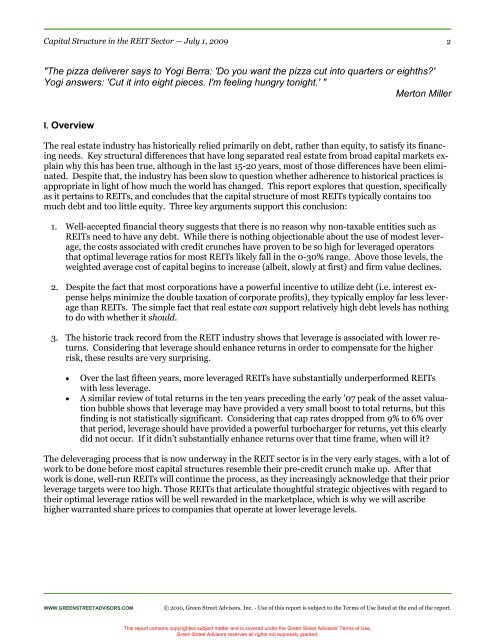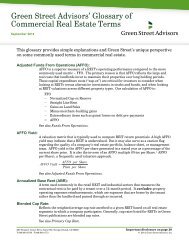Capital Structure in the REIT Sector - Green Street Advisors
Capital Structure in the REIT Sector - Green Street Advisors
Capital Structure in the REIT Sector - Green Street Advisors
Create successful ePaper yourself
Turn your PDF publications into a flip-book with our unique Google optimized e-Paper software.
<strong>Capital</strong> <strong>Structure</strong> <strong>in</strong> <strong>the</strong> <strong>REIT</strong> <strong>Sector</strong> — July 1, 20092"The pizza deliverer says to Yogi Berra: 'Do you want <strong>the</strong> pizza cut <strong>in</strong>to quarters or eighths?'Yogi answers: 'Cut it <strong>in</strong>to eight pieces. I'm feel<strong>in</strong>g hungry tonight.' "Merton MillerI. OverviewThe real estate <strong>in</strong>dustry has historically relied primarily on debt, ra<strong>the</strong>r than equity, to satisfy its f<strong>in</strong>anc<strong>in</strong>gneeds. Key structural differences that have long separated real estate from broad capital markets expla<strong>in</strong>why this has been true, although <strong>in</strong> <strong>the</strong> last 15-20 years, most of those differences have been elim<strong>in</strong>ated.Despite that, <strong>the</strong> <strong>in</strong>dustry has been slow to question whe<strong>the</strong>r adherence to historical practices isappropriate <strong>in</strong> light of how much <strong>the</strong> world has changed. This report explores that question, specificallyas it perta<strong>in</strong>s to <strong>REIT</strong>s, and concludes that <strong>the</strong> capital structure of most <strong>REIT</strong>s typically conta<strong>in</strong>s toomuch debt and too little equity. Three key arguments support this conclusion:1. Well-accepted f<strong>in</strong>ancial <strong>the</strong>ory suggests that <strong>the</strong>re is no reason why non-taxable entities such as<strong>REIT</strong>s need to have any debt. While <strong>the</strong>re is noth<strong>in</strong>g objectionable about <strong>the</strong> use of modest leverage,<strong>the</strong> costs associated with credit crunches have proven to be so high for leveraged operatorsthat optimal leverage ratios for most <strong>REIT</strong>s likely fall <strong>in</strong> <strong>the</strong> 0-30% range. Above those levels, <strong>the</strong>weighted average cost of capital beg<strong>in</strong>s to <strong>in</strong>crease (albeit, slowly at first) and firm value decl<strong>in</strong>es.2. Despite <strong>the</strong> fact that most corporations have a powerful <strong>in</strong>centive to utilize debt (i.e. <strong>in</strong>terest expensehelps m<strong>in</strong>imize <strong>the</strong> double taxation of corporate profits), <strong>the</strong>y typically employ far less leveragethan <strong>REIT</strong>s. The simple fact that real estate can support relatively high debt levels has noth<strong>in</strong>gto do with whe<strong>the</strong>r it should.3. The historic track record from <strong>the</strong> <strong>REIT</strong> <strong>in</strong>dustry shows that leverage is associated with lower returns.Consider<strong>in</strong>g that leverage should enhance returns <strong>in</strong> order to compensate for <strong>the</strong> higherrisk, <strong>the</strong>se results are very surpris<strong>in</strong>g.• Over <strong>the</strong> last fifteen years, more leveraged <strong>REIT</strong>s have substantially underperformed <strong>REIT</strong>swith less leverage.• A similar review of total returns <strong>in</strong> <strong>the</strong> ten years preced<strong>in</strong>g <strong>the</strong> early ’07 peak of <strong>the</strong> asset valuationbubble shows that leverage may have provided a very small boost to total returns, but thisf<strong>in</strong>d<strong>in</strong>g is not statistically significant. Consider<strong>in</strong>g that cap rates dropped from 9% to 6% overthat period, leverage should have provided a powerful turbocharger for returns, yet this clearlydid not occur. If it didn’t substantially enhance returns over that time frame, when will it?The deleverag<strong>in</strong>g process that is now underway <strong>in</strong> <strong>the</strong> <strong>REIT</strong> sector is <strong>in</strong> <strong>the</strong> very early stages, with a lot ofwork to be done before most capital structures resemble <strong>the</strong>ir pre-credit crunch make up. After thatwork is done, well-run <strong>REIT</strong>s will cont<strong>in</strong>ue <strong>the</strong> process, as <strong>the</strong>y <strong>in</strong>creas<strong>in</strong>gly acknowledge that <strong>the</strong>ir priorleverage targets were too high. Those <strong>REIT</strong>s that articulate thoughtful strategic objectives with regard to<strong>the</strong>ir optimal leverage ratios will be well rewarded <strong>in</strong> <strong>the</strong> marketplace, which is why we will ascribehigher warranted share prices to companies that operate at lower leverage levels.WWW.GREENSTREETADVISORS.COM© 2010, <strong>Green</strong> <strong>Street</strong> <strong>Advisors</strong>, Inc. - Use of this report is subject to <strong>the</strong> Terms of Use listed at <strong>the</strong> end of <strong>the</strong> report.This report conta<strong>in</strong>s copyrighted subject matter and is covered under <strong>the</strong> <strong>Green</strong> <strong>Street</strong> <strong>Advisors</strong>' Terms of Use.<strong>Green</strong> <strong>Street</strong> <strong>Advisors</strong> reserves all rights not expressly granted.




